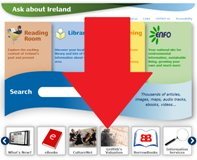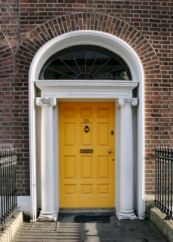- Home ›
- Irish Land records ›
- Griffith's Valuation
Griffith's Valuation - a mid-19th century gem
Richard Griffith's Valuation is one of the great gems among Irish genealogy resources. In the absence of any surviving pre-1901 censuses, beyond a few precious fragments and transcriptions, it is the most comprehensive mid-19th century resource available and can help direct genealogists to the exact plot of land where their ancestors lived.
 Once a home, now a ruin: a property in rural County Cork
Once a home, now a ruin: a property in rural County CorkIt was not, however, a census, nor was it intended to be one.
Instead, it was a land survey and, as such, it has some limitations because it was not designed to do what we family historians, more than one and a half centuries later, would really like it to do! That is, locate and deliver our ancestors. If only!
Even so, Griffith's Valuation may be able to move your search on. To get the best from it, it's worth appreciating its purpose at the time it was compiled, understanding the instructions given by Richard Griffiths to the valuers/surveyors who gathered the information, and knowing the year it was carried out in your ancestor's county (see date map).
Griffith's Valuation: its original purpose
In the early 19th century, taxes were based on property and
the methods of calculation varied from county to county. The Government wanted
to create a consistent system and needed to find out who its people were and
how much they might be able to tax them, so it tasked Richard Griffith, the
director of the Valuation Office in Dublin, to carry out a land survey.
The result was Griffith's Valuation – full name The General Valuation of the Rateable Property in Ireland but also known as the Primary Valuation (of Tenements) – a detailed guide of the property, land and households of mid-19th-century Ireland.
It is not a census. It covers who owned what and who rented what, and assessed the value on which each identifiable 'parcel' of land and/or property should be taxed.
Only the head of each household is identified. Family relationships and other personal information were not recorded.
For this reason, few women and no children are included. The very poorest ie those who lived on the verge of vagrancy in makeshift or temporary hovels were also excluded. Their numbers were small.
Griffith's Valuation: its value for genealogists
So who is it of use to? Nearly all Irish family historians will find Griffith's Valuation useful, and most will start with the Primary Valuation of Tenements, published county-by-county across the island between 1847 and 1864. See sample of a page from County Carlow above.
Surname Research
For researchers who don't know where their ancestors lived, Griffith's Valuation can help narrow down locations where their surname was most prevalent and so identify areas for further study.
A printed Index to Householders, showing how many times a particular surname appears in each region, is available in many repositories and can also be readily found online.

However, Ask About Ireland is now the easiest way to search Griffith's Valuation by surname or placename. It's also free to access.
From the Home Page (see image above) the Griffith's Valuation section is clearly marked.
Surname Research
For researchers who don't know where their ancestors lived, Griffith's Valuation can help narrow down locations where their surname was most prevalent and so identify areas for further study.
A printed Index to Householders, showing how many times a particular surname appears in each region, is available in many repositories and can also be readily found online.

Ask About Ireland is now the easiest way to search Griffith's Valuation by surname or placename. It's also free to access. From the Home Page (see image above) the Griffith's Valuation section is clearly marked.
If you don't know where your family lived, you may be able to narrow down the possibilities by finding the parishes where your ancestor's surname was prevalent.
This can help you identify the most appropriate church registers to start your search. If your ancestor emigrated in the mid- to late-1800s, you may find him, her or family at home before he left.
Even if he set sail before Griffith's Valuation was published (1847-1864, depending on county) and subsequently married abroad, you should find his father's name on both his marriage certificate and in the Primary Valuation at the ancestral home.
If you already know your ancestors' townland (whether or not they emigrated), Griffith's Valuation will also allow you to collect detailed information about their lives and their neighbourhood.
Some of this detail may be found in the
Notebooks used by the valuers as they carried out their work, or in the
Cancelled Land Books, also known as the Revision Books. See the Valuation Books page.
Each entry in Griffith's Valuation contains:
- The Ordnance Survey map reference number
- The townland or street where the property is located
- The name of the occupier (see box to the right)
- The name of the immediate lessor ie the landlord
- A brief description of the property ('house, offices and land')
- The land area of occupier's holding, in acres, roods and perches
- The annual valuation of the land and buildings
Each entry in Griffith's Valuation contains:
~ The Ordnance Survey map reference number
~ The townland or street where the property is located
~ The name of the occupier (see box to the right)
~ The name of the immediate lessor ie the landlord
~ A brief description of the property ('house, offices and land')
~ The land area of occupier's holding, in acres, roods and perches
~ The annual valuation of the land and buildings
How is Griffith's Valuation arranged?
The Valuation is arranged by county, barony, Poor Law Union, civil parish and townland (see Irish land divisions if you are unfamiliar with these terms).
 ...to the poorest hovel in rural Ireland.
...to the poorest hovel in rural Ireland. All property was included, from the smartest Dublin home...
All property was included, from the smartest Dublin home...It lists pretty much every occupier of property in Ireland. In rural areas this meant every dwelling while in urban areas it also meant every household within multiple occupancy buildings ie tenements.
The information collected from each occupier was cross-referenced with the Ordnance Survey map of Ireland so that each individual occupier is identified by townland name (or street address).
 All property was included, from the smartest Dublin home...
All property was included, from the smartest Dublin home... ...to the poorest hovel in rural Ireland.
...to the poorest hovel in rural Ireland.In addition, the following details are recorded:
–
the name of the occupiers landlord ie the person from whom the occupier was
renting (immediate lessor)
– a brief description of the property and its acreage
– a valuation of land and buildings.
Each occupiers reference can be found on the relevant Ordnance Survey maps (which survive intact). This allows todays genealogists to identify the exact piece of land their ancestors lived on back then.
To understand the information presented, see the detailed examples on the Richard Griffith's Valuation – Unlock the Code page.
Where can Griffith's Valuation be studied?
Online
Griffith's Primary Valuation of Tenements is now widely available online. It is available on Ancestry (in the Irish Wills, probate & tax collection) and FindMyPast as part of their subscription packages, and – for free – on AskAboutIreland (see Surname Research box above).
Like father, like son
The men who worked as Valuers were native-born Irish and understood traditional naming patterns and the use of a father's first name to distinguish between men who had the same name.
In townlands where a surname was common, the Valuers distinguished between individuals in various ways.
Typically, they would add, in brackets after a person's name, the first name of that person's father.
So, for example, John Tobin (Patrick) is the son of Patrick Tobin, whereas John Tobin (Michael) is the son of Michael Tobin.
Where relevant, the abbreviations Snr (Senior, or father) and Jnr (Junior, or son) were sometimes used.
Similarly, occupations were often used as identifiers ie Jeremiah Crowley (farmer) and Jeremiah Crowley (victualler).
Such entries can be a huge bonus because there may be no other document in existence to provide these family connections between the individuals named. They're 'genealogical gold'!
Original maps – those created as part of Griffith's
Valuation – can be viewed at FindMyPast... the only online database to match a
searchable Valuation to original maps. Slightly later maps can be married to
Valuation searches (free) on AskAboutIreland.
Valuers' Notebooks, Cancelled/Revision books and Current Land Books: Only the Revision Books for Northern Ireland counties are available online. Some of the Valuers/Surveyors' Notebooks are held on the National Archives of Ireland's NAI-Genealogy portal, free, and (the same) collection is searchable on FindMyPast.
Like father, like son
The men who worked as Valuers were native-born Irish and understood traditional naming patterns and the use of a father's first name to distinguish between men who had the same name.
In townlands where a surname was common, the Valuers distinguished between individuals in various ways.
Typically, they would add, in brackets after a person's name, the first name of that person's father.
So, for example, John Tobin (Patrick) is the son of Patrick Tobin, whereas John Tobin (Michael) is the son of Michael Tobin.
Where relevant, the abbreviations Snr (Senior, or father) and Jnr (Junior, or son) were sometimes used.
Similarly, occupations were often used as identifiers ie Jeremiah Crowley (farmer) and Jeremiah Crowley (victualler).
Such entries can be a huge bonus because there may be no other document in existence to provide these family connections between the individuals named. They're 'genealogical gold'!
Offline
Some 301 volumes, published 1847 to 1864, make up the complete Griffith's Primary Valuation of Tenements. No single repository holds the entire original collection.
However, in various states of incompleteness (or even just per county) it may be available on microfiche or photocopy in local and regional libraries across Ireland and at the major institutions in Dublin (the National Library, National Archives and the Valuation Office) and in Belfast (the Public Record Office of Northern Ireland).
The original maps are held by the National Archives of Ireland in Dublin. Scanned images are available at the Valuation Office in Dublin.
Valuers' Notebooks, Cancelled/Revision books and Current Land Books: These are pre- and post-publication manuscript books.
They are not a researcher's first port of call, but can be extremely useful for further research after studying the Primary Valuation of Tenements. See link in the Where Next? section below.
Where next?
~ The best place to access
Griffith's Primary Valuation online is Ask about Ireland,
a
government-sponsored site. It can be searched by surname, or by
place
name. It's free. But, at July 2022, you take pot-luck with it.
The site is being slowly upgraded. Very slowly. And you may find access
tricky to some or all parts of the Griffith's Valuation section. It may
be months before the site is upgraded and reliable. If you cannot access
it, try FindMyPast (links above) but you'll have to pay.
~ Find out more about Valuers' Notebooks, Cancelled/Revision Books and Current Land Books.
~ Some tactics for narrowing down and finding the townland where your ancestors lived.
The Family Tree Irish Genealogy Guide
Written by the creator of Irish Genealogy Toolkit and Irish Genealogy News, 'The Family Tree Irish Genealogy Guide' is full of advice, tips and strategies to ease what can be a challenging journey.
Its guidance will be useful to any researcher of Irish heritage, but especially for the target Irish-American researcher who's struggling to work back to Ireland from their immigrant ancestor.
Publisher: Penguin
ISBN: 9781440348808 / 240 pages.



